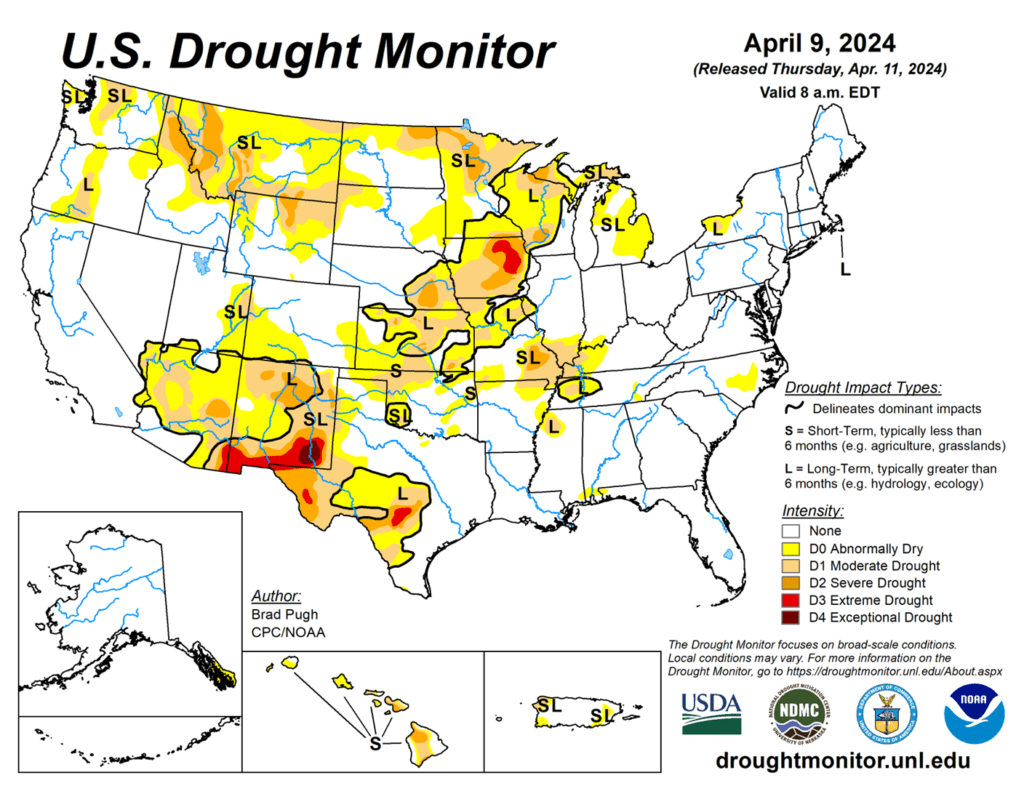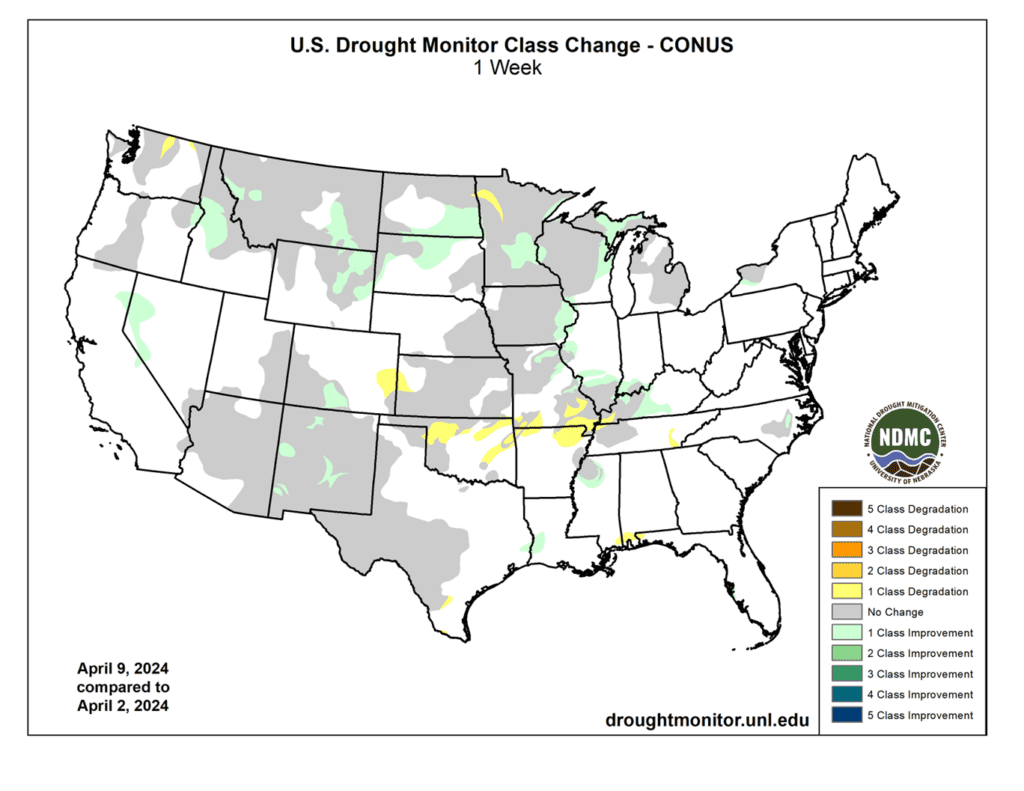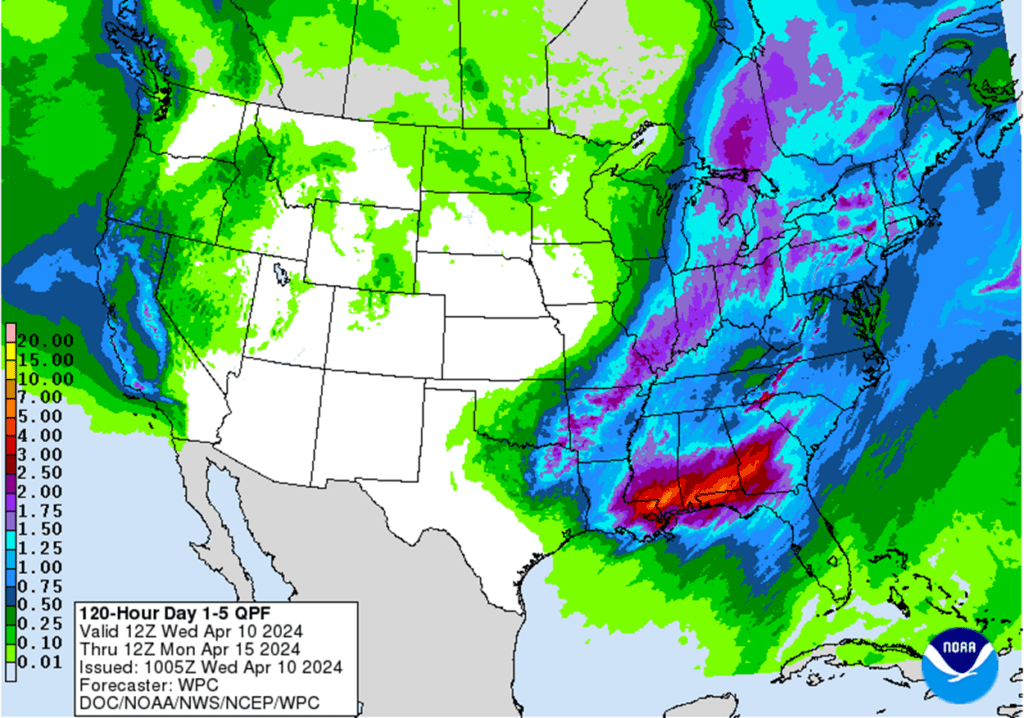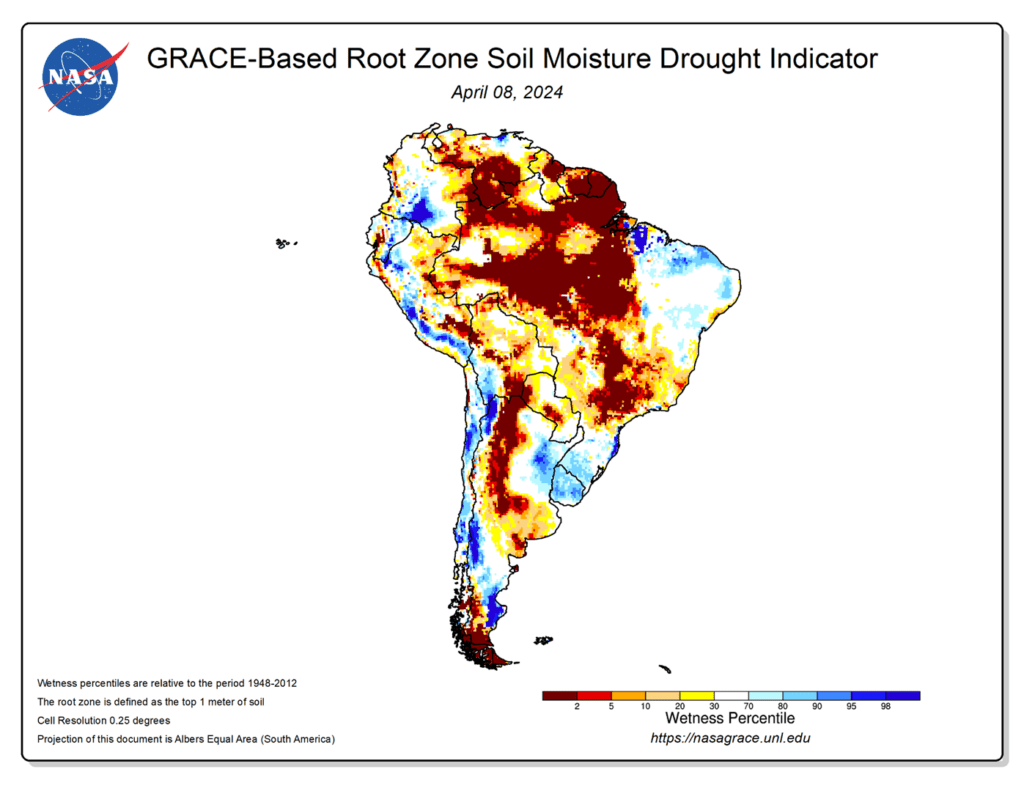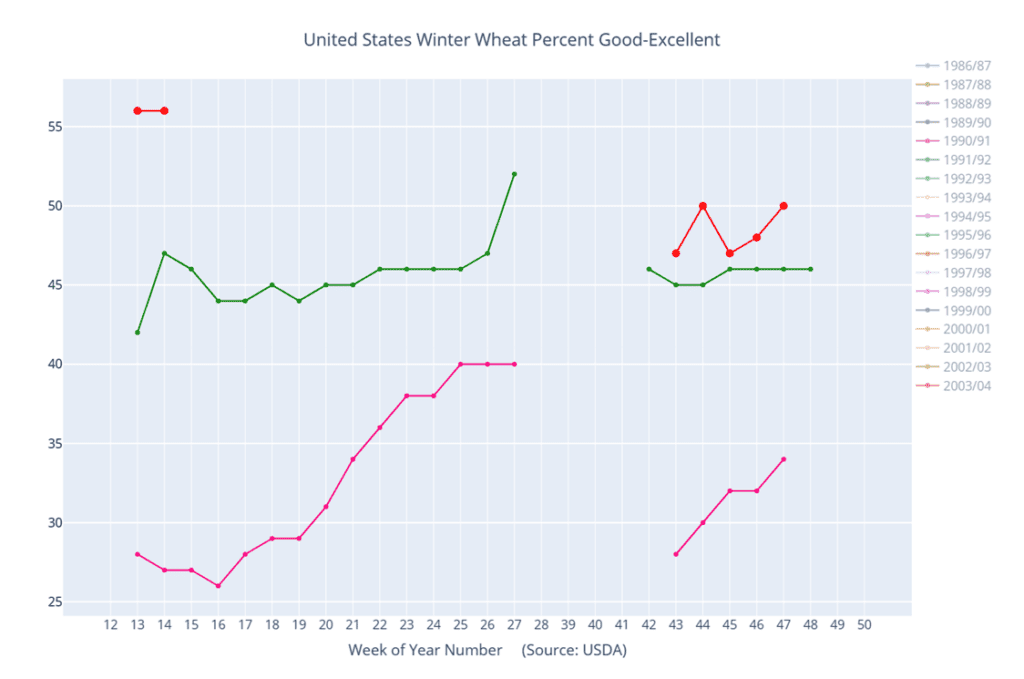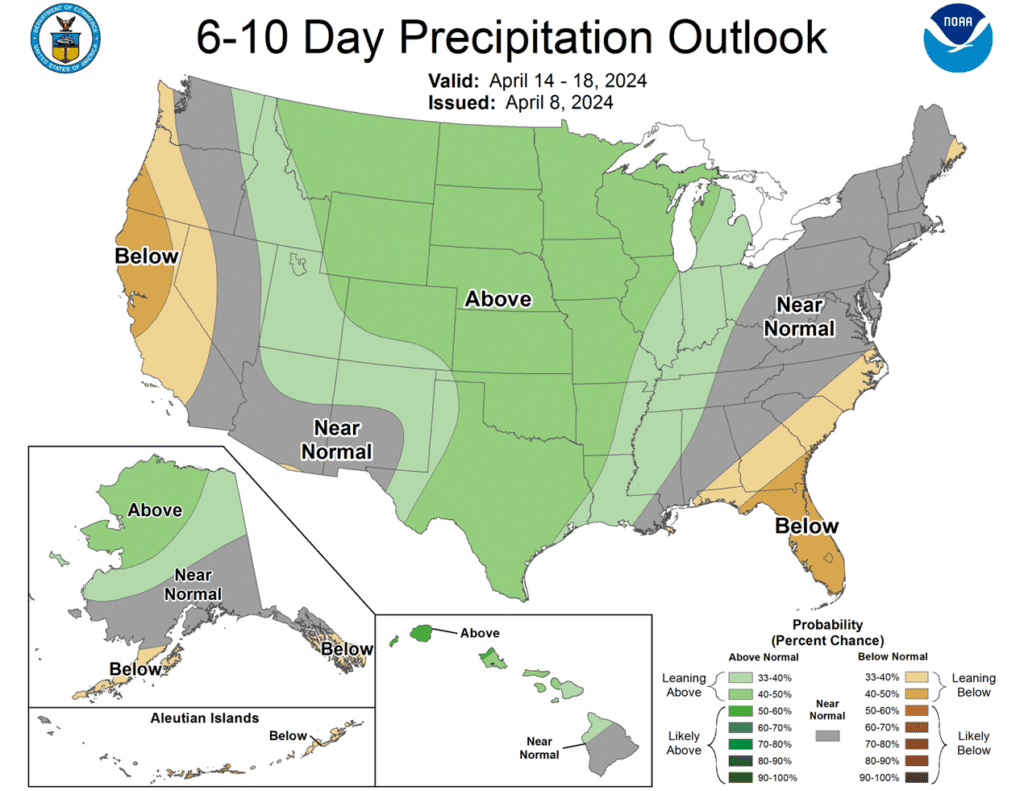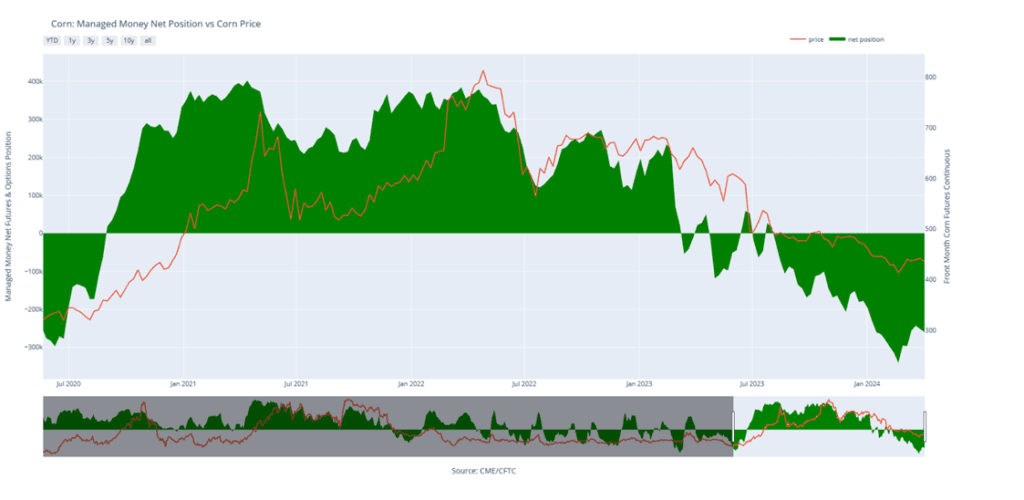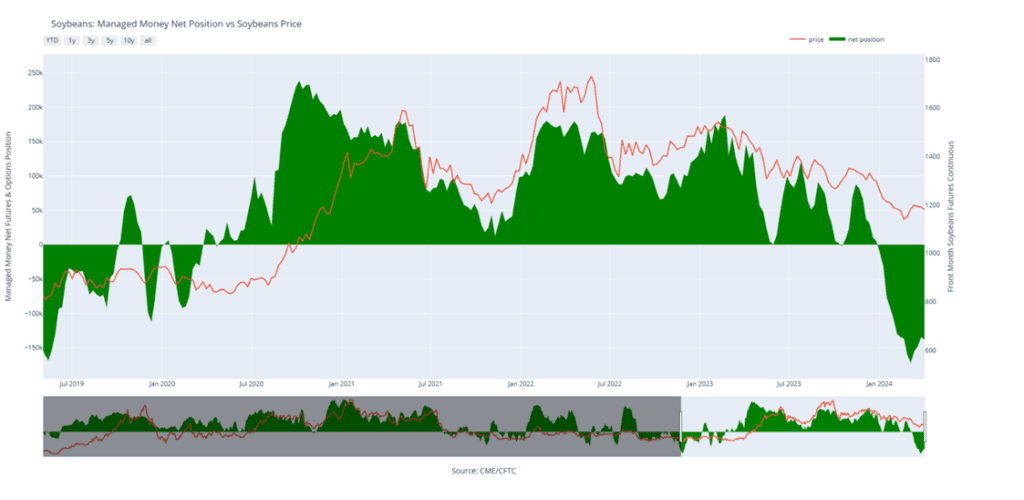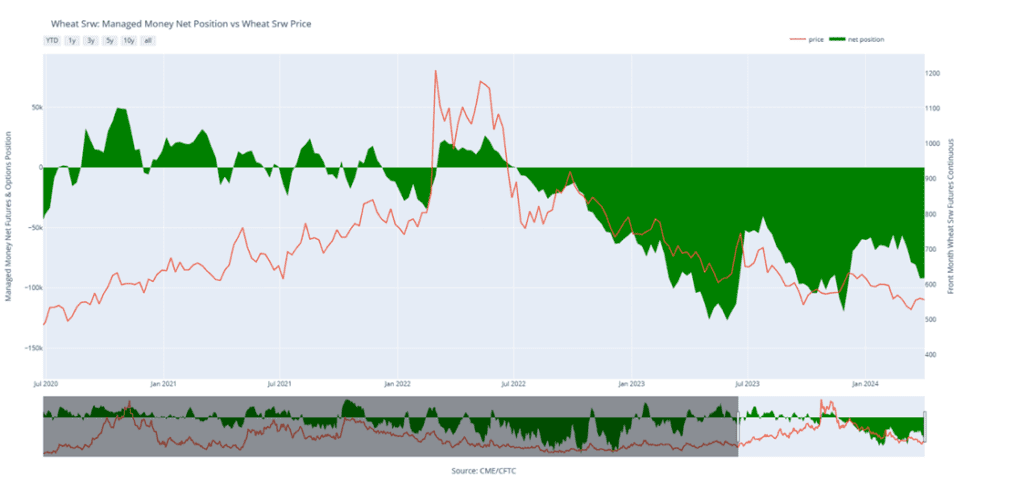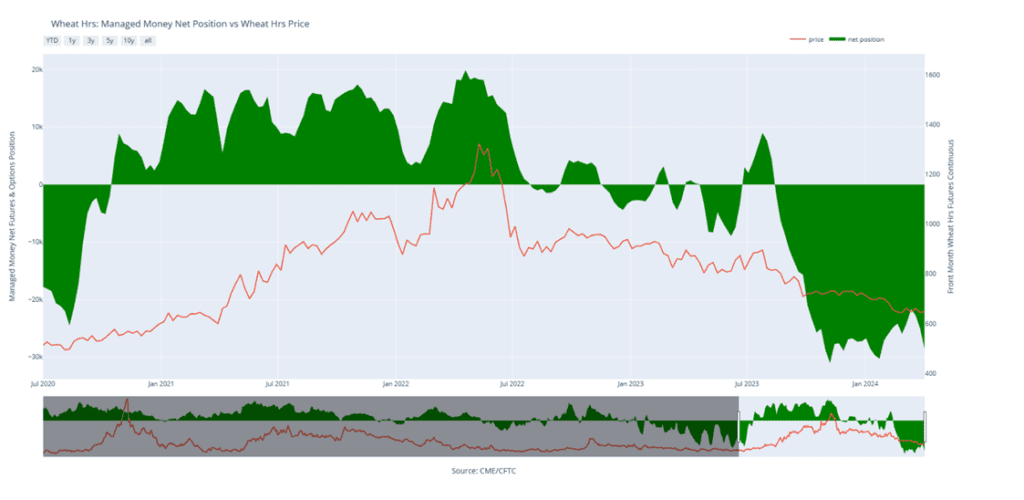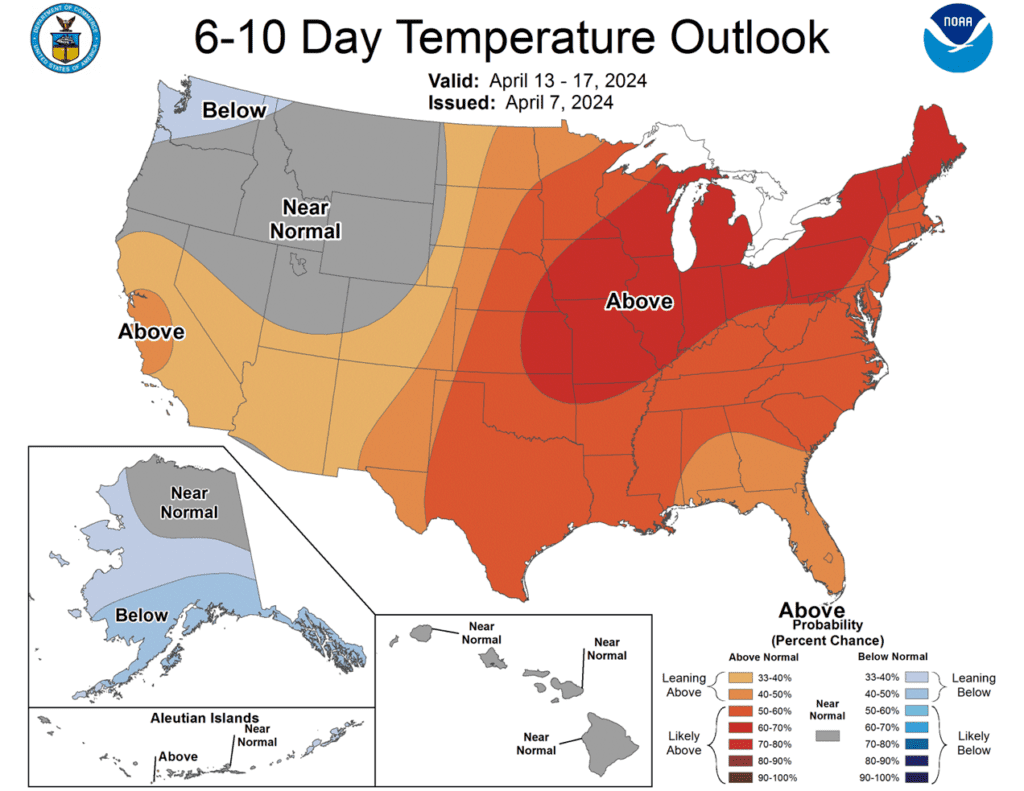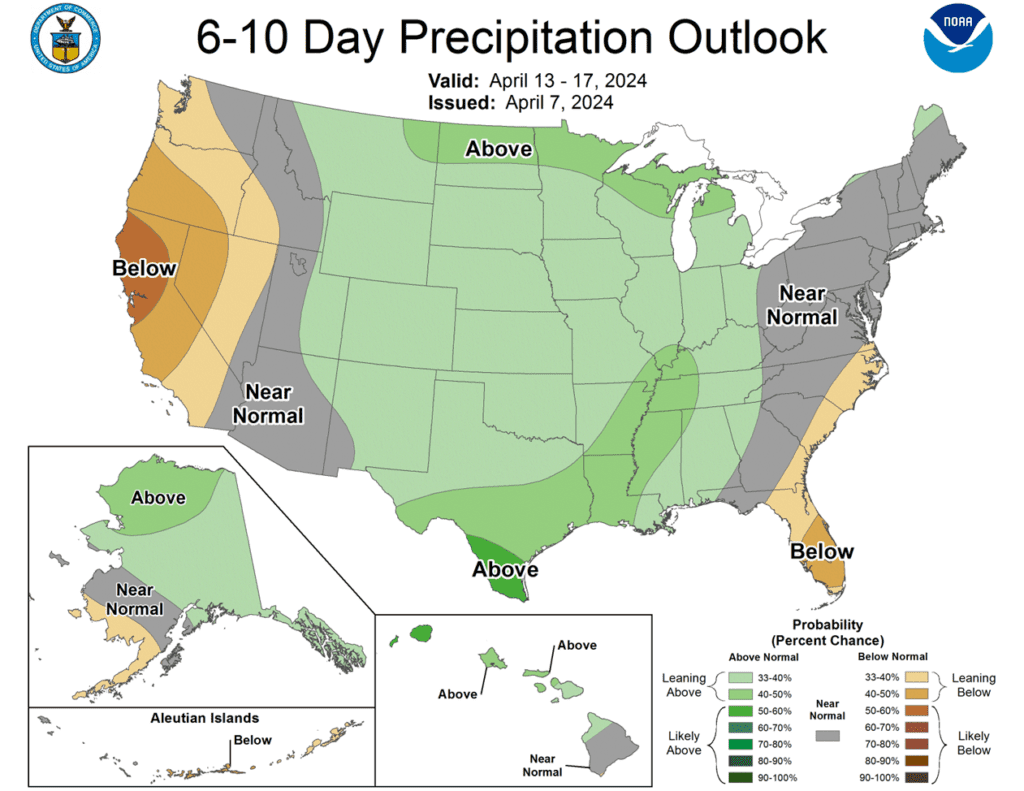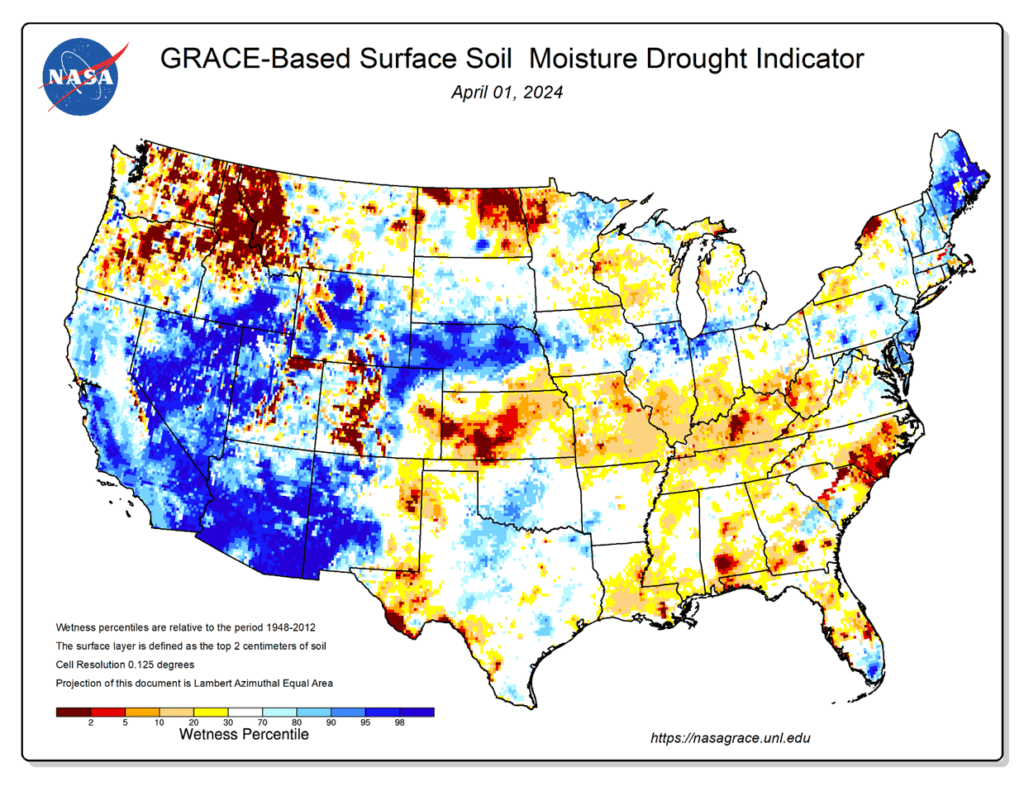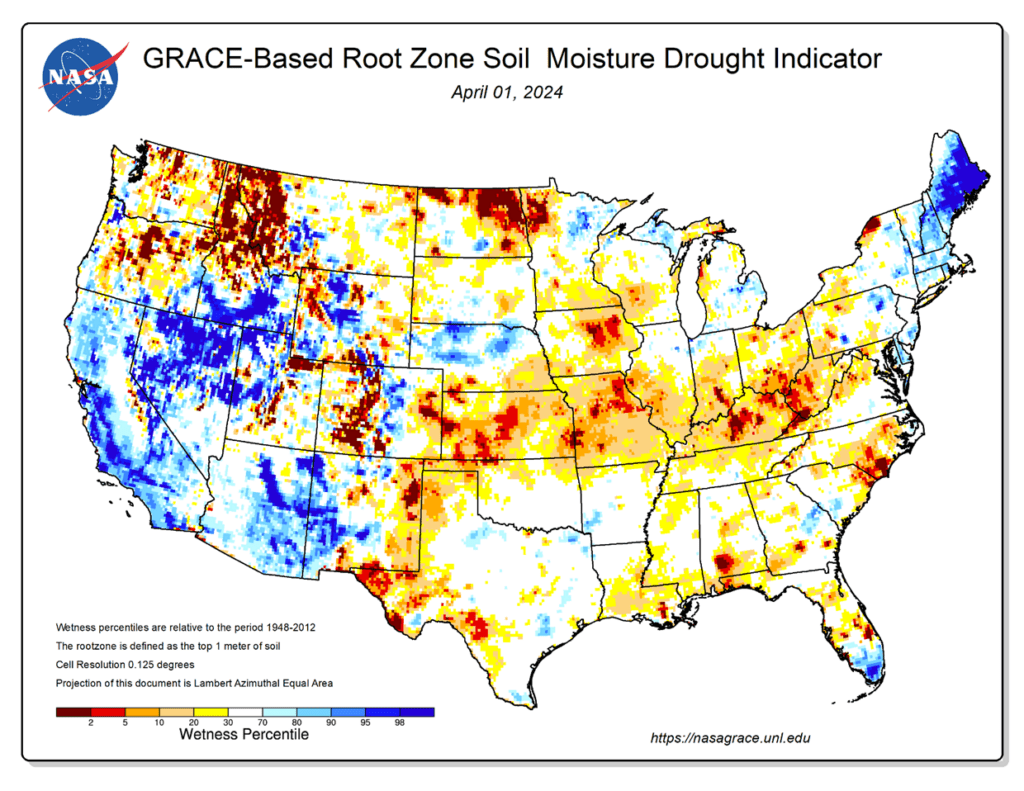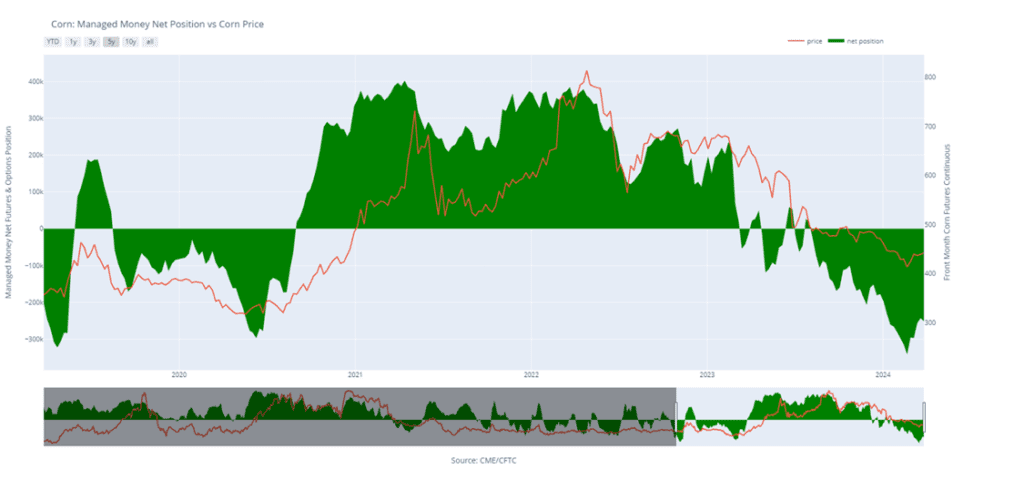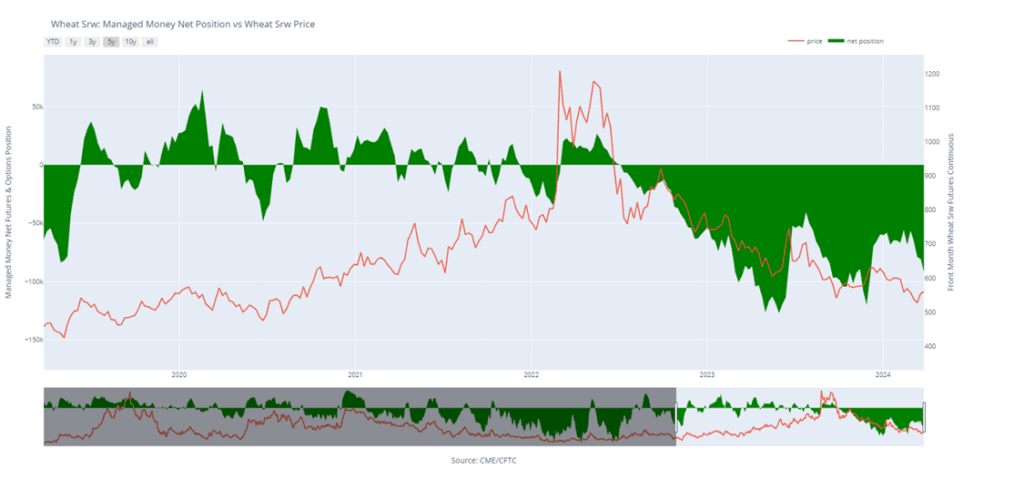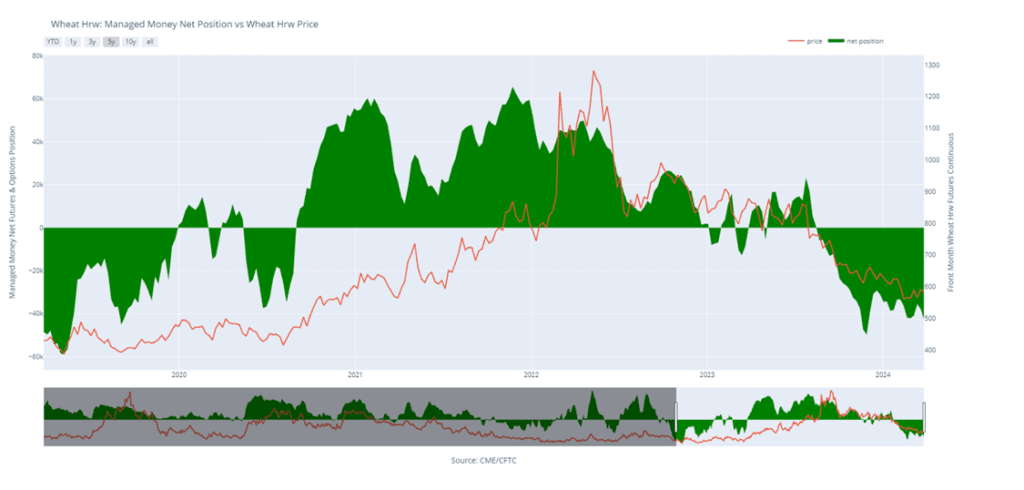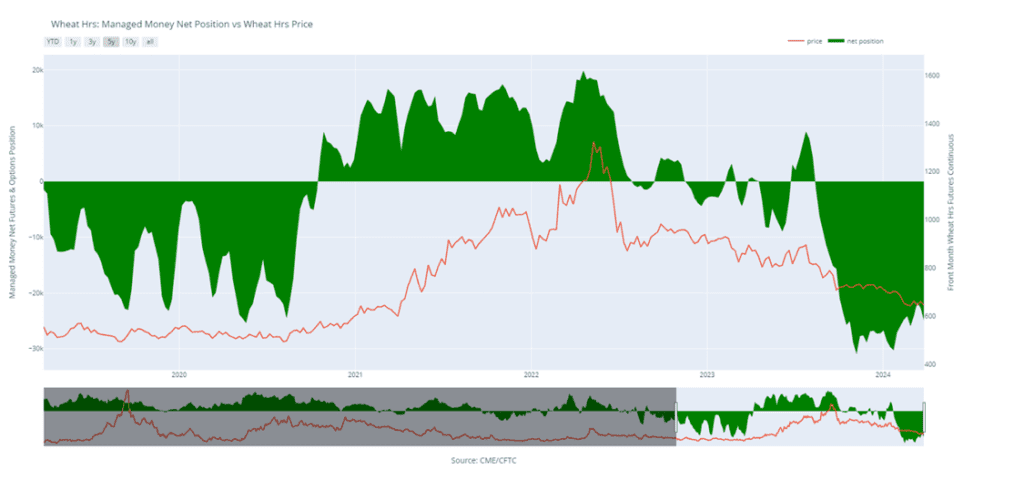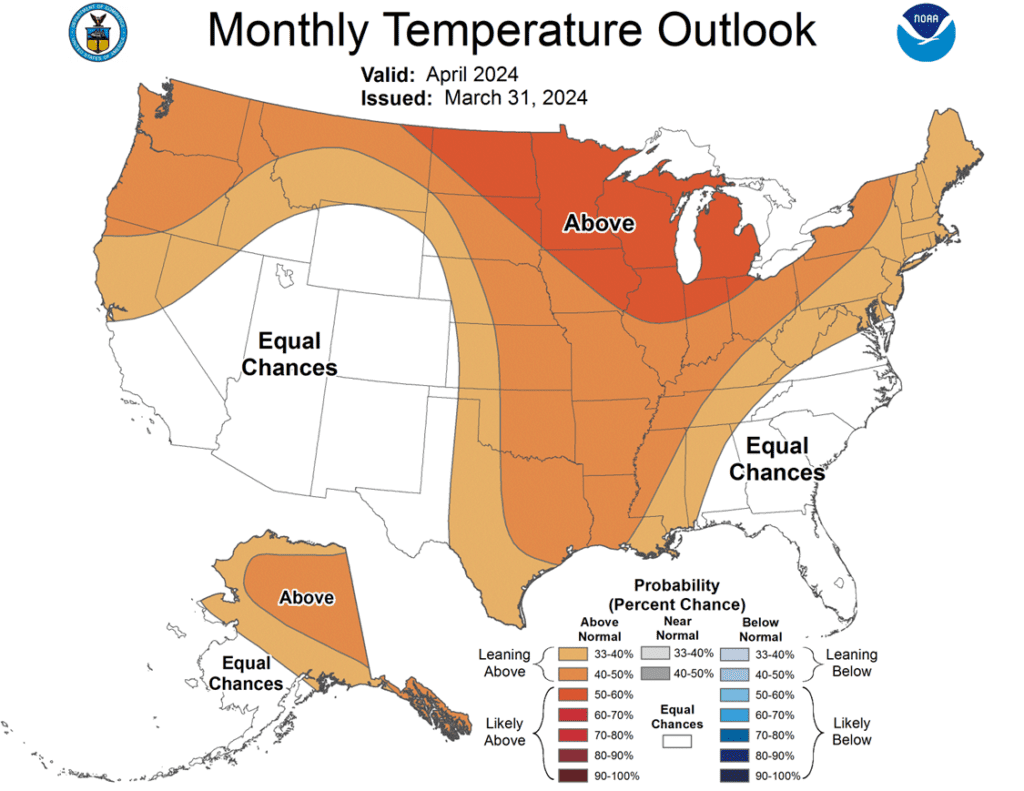4-12 End of Day: Markets Recover from Yesterday’s Bearish Report and Close in the Green
All prices as of 2:00 pm Central Time
Grain Market Highlights
- The corn market rebounded from yesterday’s losses and selling pressure throughout the week to settle within 2 cents of the day’s highs and post a 1 ¼ cent net gain on the week. Although prices closed at the upper end of the day’s range, they remain largely rangebound.
- After a modest start to the day, soybeans gained strength following the report of a third flash sale for the week to unknown destinations and closed the day near the top end of a 25 ¾ cent range. Further support came from sharply higher soybean meal, which could have triggered some short covering going into the weekend.
- All three wheat classes closed higher today, mirroring the uptrend in Matif wheat. Heightened tensions in the Middle East and Black Sea regions possibly fueled the market’s rebound from yesterday’s somewhat bearish USDA report and the strengthening US Dollar Index. KC and Minneapolis wheat closed near their session highs, while Chicago wheat settled in the middle of its trading range.
- To see the updated US 5-day precipitation forecast, 6 – 10 day temperature and precipitation outlooks, and 1 and 2-week precipitation forecasts for Brazil and N. Argentina, courtesy of the NWS and NOAA scroll down to the other Charts/Weather section.
Note – For the best viewing experience, some Grain Market Insider content is best viewed with your phone held horizontally.
Corn
Corn Action Plan Summary
From the low on February 26 to the high on March 12, May corn experienced a significant rally of nearly 40 cents. However, since then, it has consolidated within a narrow trading range, fluctuating mostly between 430 and 445. During this period, Managed Money has reduced its net short position by approximately 53,000 contracts, although it still holds a historically large short position of around 252,000 contracts. The size of Managed Money’s net short position, coupled with prevailing macro oversold conditions, suggests potential for further upside as we head into spring planting. While the recovery in corn prices may encounter obstacles, overall market conditions remain conducive to a continued price recovery into May and June.
- No new action is recommended for 2023 corn. The target range to make additional sales is 480 – 520 versus May ’24 futures. If you need to move bushels for cash or logistics reasons, consider re-owning any sold bushels with September call options.
- No new action is recommended for 2024 corn. We are targeting 520 – 560 to recommend making additional sales versus Dec ‘24 futures. For put option hedges, we are looking for 500 – 520 versus Dec ‘24 before recommending buying put options on production that cannot be forward priced prior to harvest.
- No Action is currently recommended for 2025 corn. At the beginning of the year, Dec ’25 corn futures left a gap between 502 ½ and 504 on the daily chart. Considering the tendency for markets to fill price gaps like these, we are targeting the 495 – 510 area to recommend making additional sales.
To date, Grain Market Insider has issued the following corn recommendations:
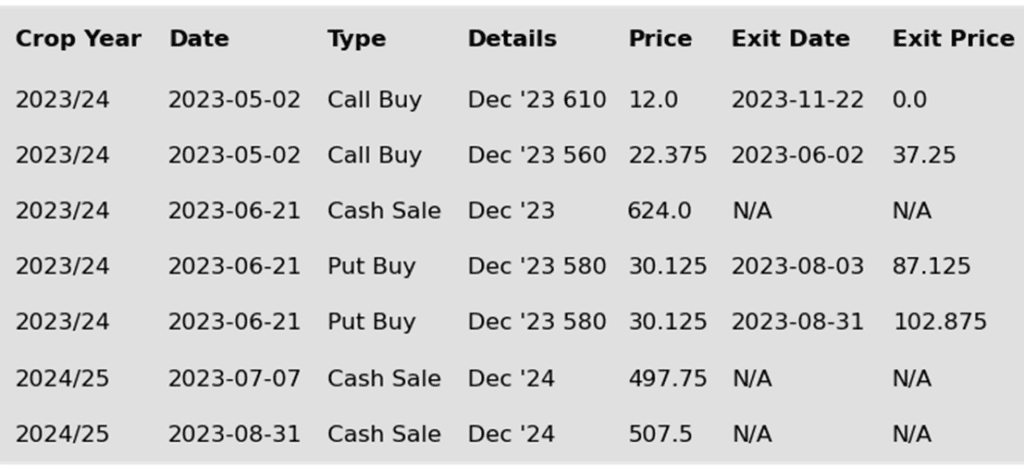
- Corn prices posted some recovery today after the USDA report yesterday and pressure throughout the week. The overall direction for the corn market is still a sideways pattern, but May corn futures closed 1 ¼ cents higher for the week.
- Argentina’s corn production saw reductions this week by groups of analysts as a leafhopper infestation has triggered infections of “Stunt disease”, limiting the yield in the soon to be harvested crop. The crop reductions have improved the premiums of Argentine corn.
- The positive on the Thursday USDA report was the increase in demand adjustments for ethanol and feed usage, reflecting the strong corn disappearance during the first quarter as shown by the USDA’s Grain Stock report.
- The current stocks-to-use ratio in corn is 14.5%, which is the largest in the past 5 years. The projected stocks-to-use ratio for the 24/25 marketing year is currently 15.9%, the highest since 2006. The large supply potential of US corn will keep rallies limited without some true bullish news event.
- Weather forecasts and the planting pace will now be the focus of the corn market. Expectations are for temperatures to stay above normal into the end of April, which could allow for planting progress to pick up speed for this year’s US corn crop. The biggest near-term concern could be wetness in the eastern Corn Belt with predicted rains.

Above: Since the beginning of March, the corn market has been trading sideways, bound mostly by 445 up top and 425 down below. If prices can breakout and close above resistance between the recent high of 448 and the January high of 452 ¼, they could run toward the next major resistance level of 495 – 510. If they break out to the downside and close below 421, they could slide further to test 400 – 410 support.
Soybeans
Soybeans Action Plan Summary
The USDA’s April Supply and Demand report failed to provide significant bullish data to prompt substantial short covering, as it mainly reflected recent demand challenges and an increase in ending stocks that aligned with the market’s expectations. However, Managed Money retains a considerable net short position near 138,000 contracts, as of the latest Commitment of Traders report. This could still fuel a short covering rally should complications arise during planting season, which has just begun. Otherwise, if weather conditions cooperate and planting progresses without major issues, prices could remain susceptible to revisiting recent lows throughout the spring.
- No new action is recommended for 2023 soybeans. We are currently targeting a rebound to the 1275 – 1325 area versus May ’24 futures to recommend making further sales. If you need to move inventory for cash or logistics reasons, consider re-owning any sold bushels with September call options.
- No new action is recommended for the 2024 crop. Considering the amount of uncertainty that lies ahead with the 2024 soybean crop, we recommended back in December buying Nov ’24 1280 and 1360 calls to give you confidence to make sales against anticipated production and to protect any sales in an extended rally. We are currently targeting the 1280 – 1320 range versus Nov ’24 futures, which is a modest retracement toward the 2022 highs, to recommend making additional sales.
- No Action is currently recommended for 2025 Soybeans. We currently aren’t considering any recommendations at this time for the 2025 crop that will be planted next year, and it may be some time before conditions are conducive to consider making any recommendations. Be patient as we monitor the markets for signs of improvement.
To date, Grain Market Insider has issued the following soybean recommendations:

- Soybeans ended the day significantly higher and ended the week with the May contract recovering most of the past two days’ losses and closing just below the 40-day moving average. End-of-week profit taking and a flash sale reported this morning were likely supportive to prices today. Soybean meal ended sharply higher while soybean oil was lower.
- For the week, May soybeans lost 11 cents, and November soybeans lost 8 ½, to close at 1174 and 1176 ¼ respectively. May soybean meal gained $11.30 to close at $344.40, and May soybean oil lost 3.00 cents and closed at 45.89 cents. The bulk of this week’s gains in soybean meal were achieved today. Soybean oil has been dragged lower by palm oil.
- This morning, the USDA reported that 124,000 metric tons of soybeans were sold to unknown destinations for the 23/24 marketing year. This was the third sale to unknown destinations announced this week and the fourth in the past two weeks after a long period with none.
- Yesterday, CONAB released its estimate for Brazilian soybean production which saw it lowered to 146.5 mmt. A few hours later, the USDA released its estimate but made no changes from last month and kept the number steady at 155 mmt. This is a large discrepancy which should narrow as harvest nears completion.

Above: After closing below the 50-day moving average and 1168 support, the market is at risk of drifting lower and testing support between 1140 and the February low of 1128 ½. However, the market is also showing signs of being oversold, which can be supportive to a move higher. For now, initial resistance lies near the 50-day moving average of 1178 ½ with heavier resistance remaining near the recent high of 1226 ¾.
Wheat
Market Notes: Wheat
- All three wheat classes finished the session with gains, despite a rising US Dollar and somewhat bearish tone to yesterday’s USDA report. It is possible that funds were covering some of their short positions in the grain complex due to global uncertainty, with two major wars escalating. There is some concern that the Israel / Hamas conflict may expand beyond that region with the threat of retaliation from Iran after recent attacks against some of their leaders.
- Paris milling wheat finished 1.75 to 2.50 Euros per mt higher today. Although it remains in a relatively sideways pattern, today’s rally may be tied to declining conditions for the French wheat crop. Conditions are reported to have declined to 64% good to excellent due to weather issues, namely overly wet weather.
- Russia is reported to have attacked and destroyed the Trypillya coal-fired power plant near Kyiv, Ukraine that provided power to about three million customers. Russia has become more aggressive towards Ukraine’s power facilities as they target infrastructure. It is worth noting that this is not the Zaporizhzhia nuclear power plant that has been in previous headlines.
- The US Dollar Index rallied above the 106 level today and at the time of writing, is maintaining that strength. The index has not been this high since early November and is showing no signs of slowing down. Though wheat finished positive today, this could act as an anchor for the market as it makes it more expensive for importing nations to buy US goods.
- The Australian Weather Bureau forecasts that the majority of their primary crop regions will experience rainfall levels ranging from median to above median during the June to August period, improving the chances for better yields of winter crops, including wheat.
Chicago Wheat Action Plan Summary
Since marking a fresh low in early March, Chicago wheat has traded mostly sideways, seeing limited upward movement due to overhead resistance. While the absence of bullish signals has been disappointing, managed funds continue to maintain a significant net short position. This suggests the potential for a short covering rally to emerge at any moment, especially as we enter the more dynamic part of the growing season.
- No new action is currently recommended for 2023 Chicago wheat. Any remaining 2023 soft red winter wheat should be getting priced into market strength. Grain Market Insider won’t have any “New Alerts” for 2023 Chicago wheat – either Cash, Calls, or Puts, as we have moved focus onto 2024 and 2025 Crop Year Opportunities.
- No new action is recommended for 2024 Chicago wheat. At the end of August, we recommended purchasing July ‘24 590 puts to prepare for further price erosion, and recently recommended exiting half of those puts to lock in gains and get closer to a net neutral cost on the remaining position. For now, we are targeting a market rebound back towards 675 – 715 versus May ’24 futures before recommending any additional sales. As for the open 590 put position, we are looking for prices between 475 – 500 versus July ’24 futures to before we recommend exiting half of the remaining July ’24 590 puts.
- No new action is currently recommended for 2025 Chicago Wheat. We recently recommended initiating your first sales for the 2025 SRW crop year as prices pressed back toward the mid-600 range to take advantage of historically good prices for next year’s crop. Since plenty of time remains to market this crop, we are looking for further price appreciation and are currently targeting the 690 – 725 area to recommend making additional sales.
To date, Grain Market Insider has issued the following Chicago wheat recommendations:
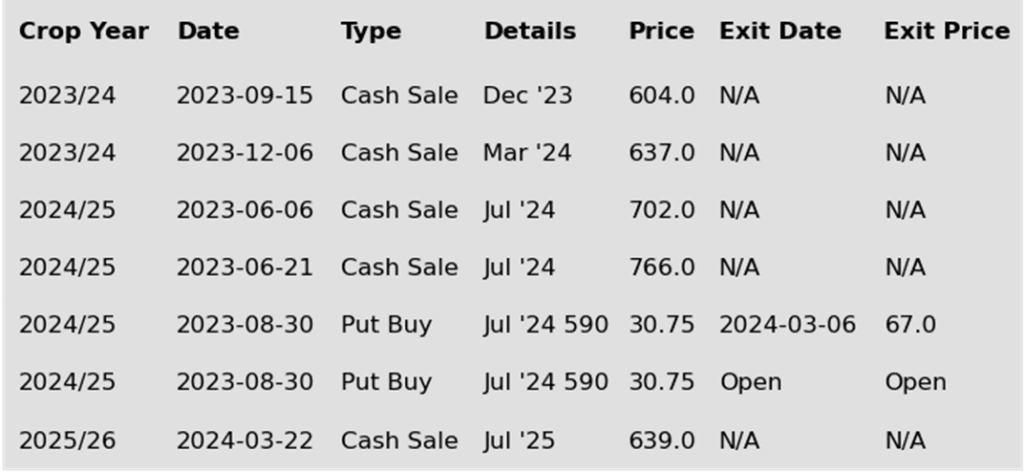

Above: The market has fallen away from the 50-day moving average and may be at risk of testing the 523 ½ low if it closes below 537. If prices turn back around and close back above the 50-day moving average, they could still encounter resistance in the 585 – 620 area.
KC Wheat Action Plan Summary
Since the end of February, prices have been trading in a broad range, bound mostly by 555 on the downside and 605 up top, with little fresh bullish news to trade, while US exports continue to suffer from lower world export prices. Although, fundamentals remain weak. Managed funds continue to hold a considerable net short position, and the market is at levels not seen since spring of 2021, which combined could trigger a return to higher prices if unforeseen risks enter the market.
- No new action is recommended for 2023 KC wheat crop. Considering the current US export demand challenges and the sideways nature of the wheat market, we are looking for prices to return to the upper end of the recent range and are targeting the 600 area versus May ’24 to recommend making additional sales.
- No new action is recommended for 2024 KC wheat. Back in August, Grain Market Insider recommended buying July ’24 KC wheat 660 puts to protect the downside, and recommended exiting the original position in three separate tranches as the market got further extended into oversold territory to protect any gains that were made. The current strategy is to target 625 – 650 versus July ’24 futures to recommend additional sales.
- No action is currently recommended for 2025 KC Wheat. We currently aren’t considering any recommendations at this time for the 2025 crop that will be planted next fall. It may be late spring or summer before Grain Market Insider starts considering the first sales targets.
To date, Grain Market Insider has issued the following KC recommendations:


Above: Significant resistance remains within the range bound by the 50-day moving average and the March 10 high of 605 ¼. A close above 605 ¼ might pave the way for further advancement toward the congestion area of 610 – 640. Otherwise, should prices retreat below the initial support level of 561, there’s a possibility of testing the March low of 551 ½.
Mpls Wheat Action Plan Summary
Minneapolis wheat has primarily traded within a range since last February until a recent breakout below its lower boundary, marking new contract lows and potentially signaling a continuation of the downtrend initiated last summer. Despite facing resistance from the 50-day moving average and a lack of bullish catalysts, seasonal patterns tend to improve heading into early summer. Furthermore, managed funds still maintain a large net short position, which might trigger a short covering rally at any time.
- No new action is currently recommended for 2023 Minneapolis wheat. The current strategy is to look for a modest retracement of the July high and target 675 – 700 to recommend more sales.
- No new action is recommended for 2024 Minneapolis wheat. Back in August, Grain Market Insider recommended buying July ’24 KC wheat 660 puts (due to their higher liquidity and correlation to Minneapolis), to protect the downside, and recommended exiting the original position in three separate tranches as the market got further extended into oversold territory to protect any gains that were made. The current strategy is targeting the 775 – 815 area versus Sept ’24 to recommend making additional sales. We are also targeting the 850 – 900 area to recommend buying upside calls to help protect any sales that would have been made.
- No action is currently recommended for the 2025 Minneapolis wheat crop. We are currently not considering any recommendations at this time for the 2025 crop that will be planted in the spring of next year. It may be late spring or summer before Grain Market Insider starts considering the first sales targets.
To date, Grain Market Insider has issued the following Minneapolis wheat recommendations:
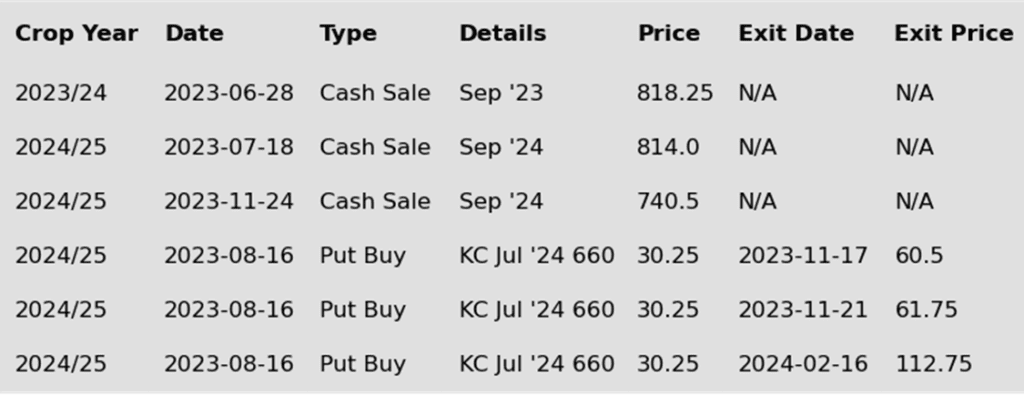

Above: The April 11 close below 638 confirmed the reversal from the 50-day moving average the day before and suggests that prices may slide lower toward the April 4 low, with psychological support near 600 and the March ’21 low of 596 ¼ below that. If bullish input enters the market to turn prices back higher, overhead resistance may still be found in the 660 – 670 area.
Other Charts / Weather
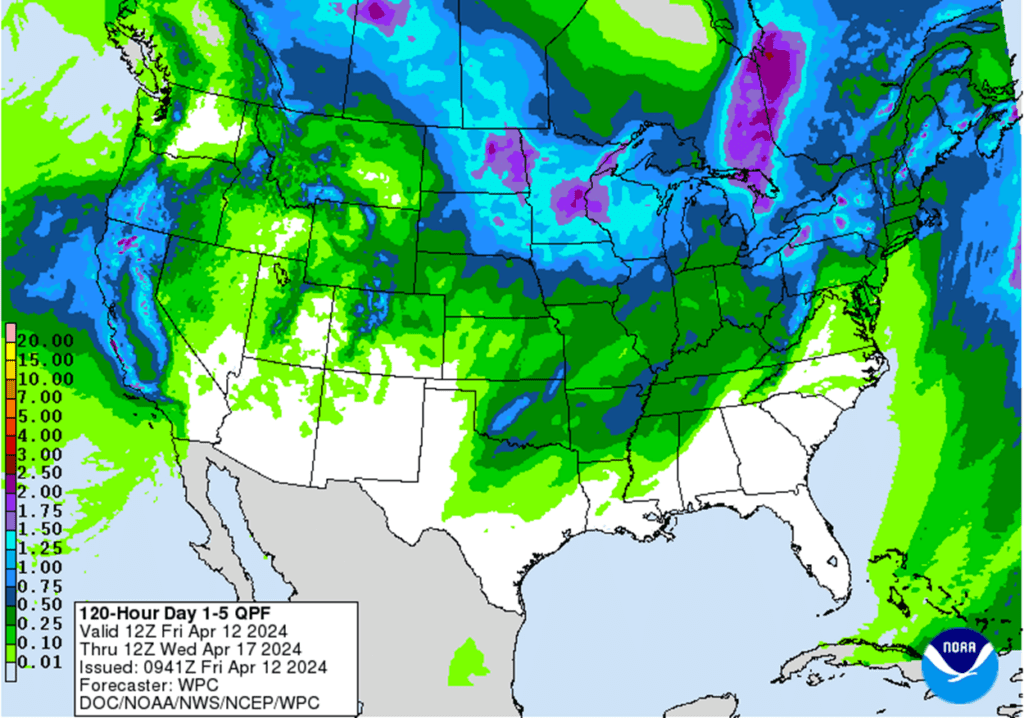
Above: US 5-day precipitation forecast courtesy of NOAA, Weather Prediction Center.
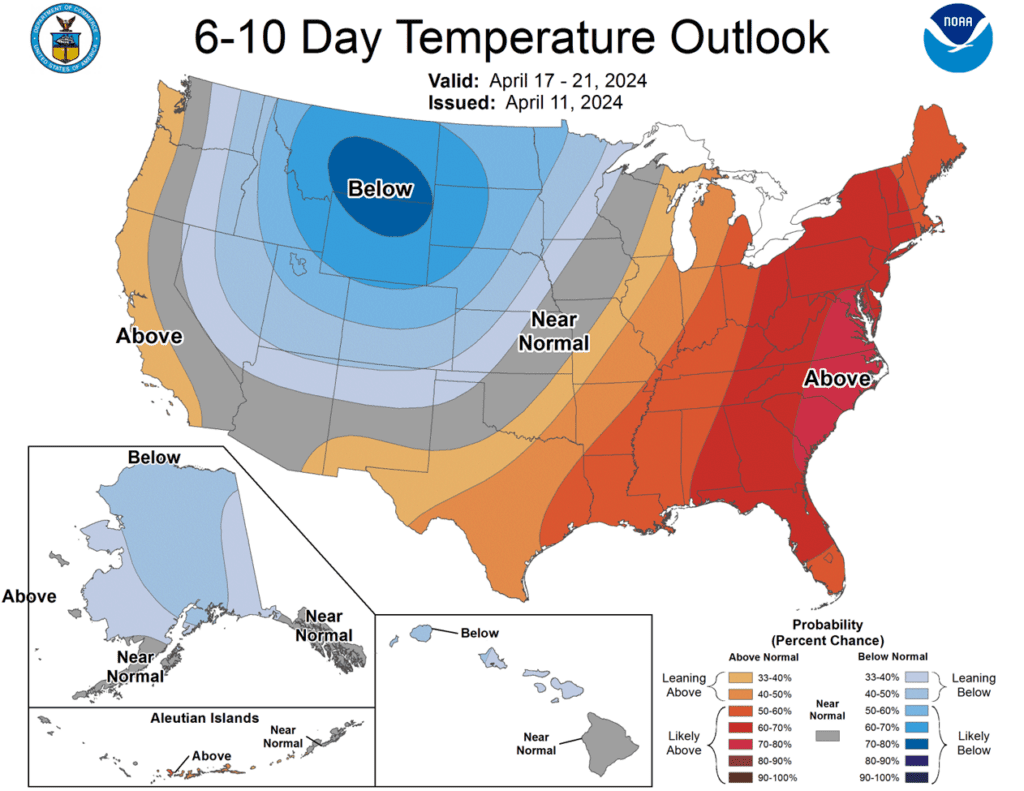
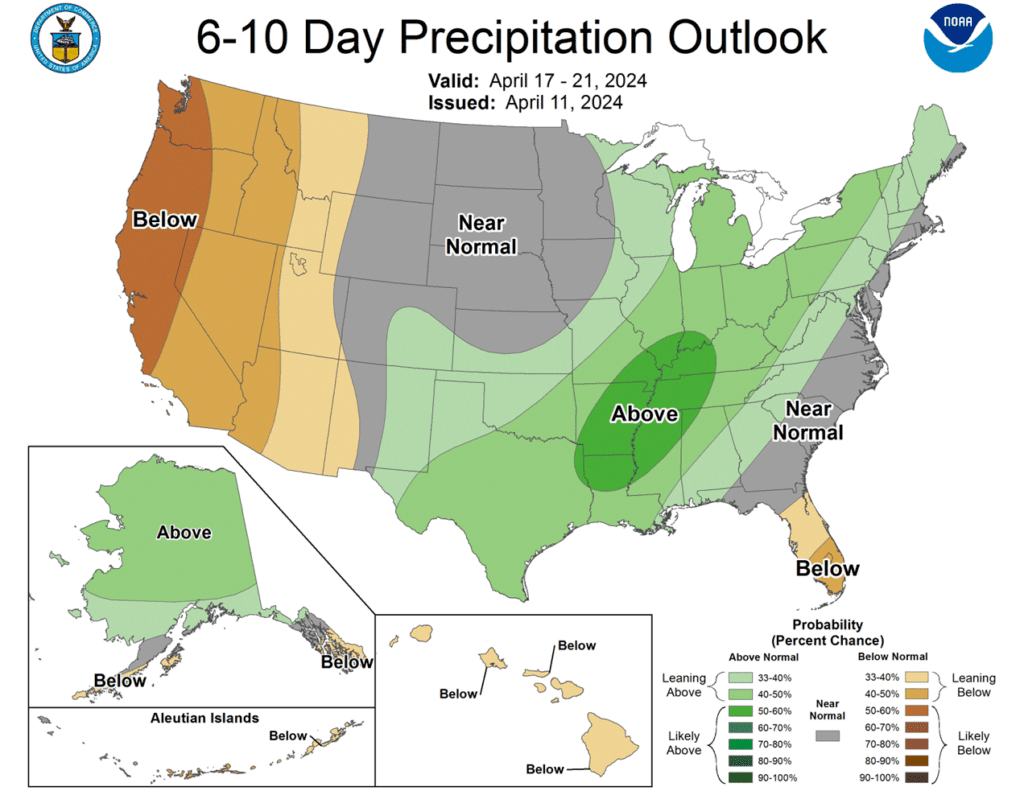

Above: Brazil and N. Argentina 1-week forecast total precipitation courtesy of the National Weather Service, Climate Prediction Center.

Above: Brazil and N. Argentina 2-week forecast total precipitation courtesy of the National Weather Service, Climate Prediction Center.










